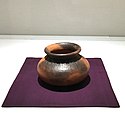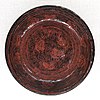Shimamono
Shimamono (島物, "island objects") is a generic term for Japanese tea utensils produced outside Japan, Korea and China, mainly from Southeast Asia.
History
[edit]Items from Korea, called kōraimono (高麗物), and from China, called karamono (唐物), are not considered shimamono.
They were imported with ships on trade routes and started becoming popular in the 15th and 16th centuries. The term therefore can be taken literally to mean "island objects". By the time of the rule of the Shōgun Tokugawa Yoshimune, imitation shimamono were also produced in Japan. However, at this point they were called "striped objects", but the pronunciation remained the same.[1] As such they can be counted as part of Japanese pottery and porcelain.
The treatise Tōkikō describes the Japanese pottery trade with Asia and gives detailed descriptions.[2]
Types
[edit]| Name | Kanji | Origins | Notes | Example image |
|---|---|---|---|---|
| Rusun ware | 呂宋焼 | Luzon | Pottery items. The merchant Ruson Sukezaemon (呂宋助左衛門) was particularly connected to the trade in Rusun ware during the rule of Toyotomi Hideyoshi in the 16th century.[3][4][5] Grouped together with Mishima ware | [6] |
| Annan ware | 安南焼 | Annam | Often blue and white pottery that was later produced in Japan as well. These were originally used as rice bowls but repurposed in Japan for tea. They feature simplified floral motifs as decoration, and their mark is an unusual high foot. A variant is in red and green colours, known as Beni Annan (紅安南). A rare chawan from the 16th century is kept at the Tokugawa Museum in Nagoya and inscribed as an Important Art Object.[7] | 
|
| Nanban ware | 南蛮焼 | Southeast Asia | Items from southeast Asia without exact provenience |  [8][9][10] [8][9][10]
|
| Amakawa | アマカワ | Macau | White clay and grayish glaze. Grouped together with Mishima ware | |
| Mōru / Mo-ru | モウル / モール | Moluccas | [11] | |
| Tō Indu / Tenji | 東インドゥ | eastern India | ||
| Kōchi ware | 交趾焼 | southern China | Developed from Cochin ware from southern China. Generally in colours yellow, green and blue. | 
|
| Nekoro | ネコロ | Nicobar Islands | ||
| Taiwan | 臺灣 | Taiwan | Grouped together with Mishima ware | |
| Hannera | ハンネラ | Southeast Asia | A type of simple unglazed ware, often reddish or orange in colour |  [12] [12]
|
| Kinma | 蒟醤 | Siam or Burma | A style of lacquer ware with finely inlaid patterns |  [13] [13]
|
| Koma | 独楽 | Siam | Lacquerware, called "spinning top" (koma) because the colours are painted in concentrical rotating patterns |  [14] [14]
|
| Sahari | 砂張 | Southeast Asia | Is a general term for metalware, specifically an alloy mainly made of copper containing a small amount of silver and lead, mainly adding tin from southeast Asia origin. It appeared from the end of the Muromachi perdiod until the Momoyama period. The products were initially not made as tea utensils, but found entry through tea masters.[15] | [16][17] |
See also
[edit]References
[edit]- ^ "Chinese Pottery in the Philippines". Field Museum of NaturalHistory. 1912.
- ^ "Chinese Pottery in the Philippines". Field Museum of NaturalHistory. 1912.
- ^ Manansala, Paul Kekai (October 2006). Quests of the Dragon and Bird Clan. Lulu.com. ISBN 9781430308997.
- ^ sambali.blogspot.com/2006/09/luzon-jars-glossary.html
- ^ http://photos1.blogger.com/blogger/6514/3214/1600/Kyoto%20002.jpg [bare URL image file]
- ^ "褐釉四耳壺(呂宋壺)".
- ^ "【重要美術品】紅安南草花文茶碗".
- ^ "常設展示:畠田光枝 南蛮焼締壺".
- ^ "石川隆児さんの南蛮焼締め碗".
- ^ "南蛮焼締花器 Nanbanyakishime vase- うつわ祥見 web shop". utsuwa-shoken.shop-pro.jp. Archived from the original on 2018-01-16.
- ^ "販売販売【茶道具】 建水 モオル 亀甲 *モール*毛織*モウル*茶道道具". seiyudo.ocnk.net. Archived from the original on 2015-12-07.
- ^ "ハンネラ建水 - Miho Museum".
- ^ "Kimma - Lacquerwares of Thailand".
- ^ "Vintage Japanese Tea Ceremony Chu-Natsume | Kagawa Lacquer Tea Caddy | 1940s | Mingei Arts". mingeiarts.com. Archived from the original on 2016-08-03.
- ^ "砂張棒の先水指 | 公益財団法人 五島美術館".
- ^ "C0077196 砂張袋形建水 - 東京国立博物館 画像検索".
- ^ "02098_001". Archived from the original on 2015-10-06. Retrieved 2018-01-15.
Literature
[edit]![]() Media related to Shimamono at Wikimedia Commons
Media related to Shimamono at Wikimedia Commons


